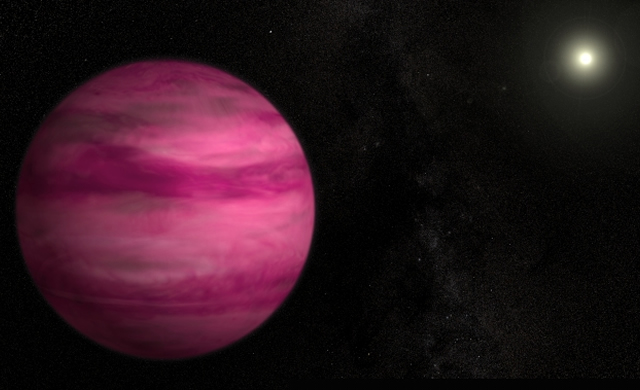
GJ 504b – Credit: NASA’s Goddard Space Flight Center/S. Wiessinger
Utilizzando i dati a infrarossi del telescopio Subaru alle Hawaii, un team internazionale di astronomi ha fotografato un pianeta gigante intorno alla luminosa stella denominata GJ 504. Più volte la massa di Giove e di dimensioni simili, il nuovo mondo, soprannominato GJ 504b, è il pianeta con massa minore mai individuato intorno ad una stella simile al sole utilizzando tecniche di imaging diretta.
“Se potessimo viaggiare su questo pianeta gigante, vedremmo un mondo ancora incandescente dal calore della sua formazione con un colore che ricorda un fiore di ciliegio scuro, magenta”, ha detto Michael McElwain, un membro del team della NASA, presso il Goddard Space Flight center di Greenbelt, nel Maryland “la nostra macchina fotografica vicina all’infrarosso rivela che il suo colore è molto più blu di altri pianeti ripresi nelle immagini, e può indicare che la sua atmosfera ha meno nuvole.” GJ 504b orbita intorno alla sua stella in circa nove volte la distanza in cui Giove orbita attorno al Sole, il che rappresenta una sfida per le teorie su come si possa formare un pianeta gigante.
Secondo il quadro più ampiamente accettato, chiamato modello “accrescimento del nucleo”, i pianeti come Giove nascono in gas ricchi di detriti in un disco che circonda una giovane stella. Il nucleo prodotto dalle collisioni tra asteroidi e comete fornisce un seme, e quando questo nucleo raggiunge la massa sufficiente, la sua attrazione gravitazionale attrae rapidamente i gas dal disco per formare il pianeta.
Using infrared data from the Subaru Telescope in Hawaii, an international team of astronomers has imaged a giant planet around the bright star GJ 504. Several times the mass of Jupiter and similar in size, the new world, dubbed GJ 504b, is the lowest-mass planet ever detected around a star like the sun using direct imaging techniques.
“If we could travel to this giant planet, we would see a world still glowing from the heat of its formation with a color reminiscent of a dark cherry blossom, a dull magenta,” said Michael McElwain, a member of the discovery team at NASA’s Goddard Space Flight Center in Greenbelt, Md. “Our near-infrared camera reveals that its color is much more blue than other imaged planets, which may indicate that its atmosphere has fewer clouds.” GJ 504b orbits its star at nearly nine times the distance Jupiter orbits the sun, which poses a challenge to theoretical ideas of how giant planets form.
According to the most widely accepted picture, called the core-accretion model, Jupiter-like planets get their start in the gas-rich debris disk that surrounds a young star. A core produced by collisions among asteroids and comets provides a seed, and when this core reaches sufficient mass, its gravitational pull rapidly attracts gas from the disk to form the planet.
Source/Continue reading → NASA.gov





















